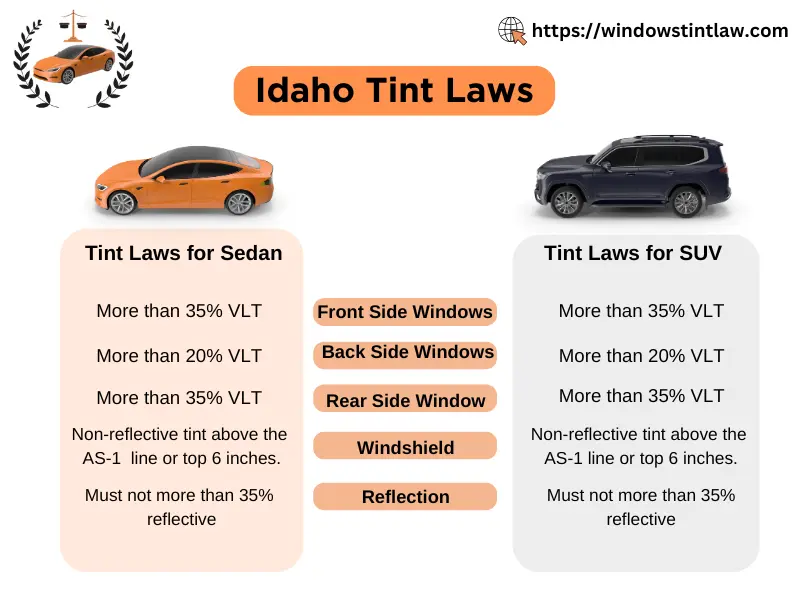Idaho tint laws were legislated in 1992 for the safety of citizens as the darker illegal window tints may cause accidents. Tint rules were enacted to prevent drivers from applying illegal tint to car windows.
Overview of Idaho Tint Laws
The below infographic outlines the allowed limits for window tint darkness and tint reflection. Drivers and vehicle owners are advised to obey these limitations to avoid tint tickets.

Darkest Legal Tint in Idaho
The darkest legal tint percentages for Sedan and SUV or Truck type vehicles are mentioned in the below table:
Window Tint Darkness For Cars and Trucks
| State | Front Side Windows | Back Side Windows | Rear Window | Windshield | Tint Reflection | Color Tints |
| Idaho | More than 35% VLT | More than 20% VLT | More than 35% VLT | Non reflective tint above the AS1 line or top 6 inches of front windshield. | Must not reflective more than 35%. | No Restriction |
Window Tint Reflection Limits
Besides the window tint darkness, tint reflection limits must be followed for vehicles registered and operated in Idaho state. According to Idaho Statutes Title 49. Motor Vehicles § 49-944, Front side windows and Back side windows of motor vehicles including Cars, SUVs or Trucks should not reflect more than 35% light. However, plus minus 3 percent variance is allowed.
Hence, Drivers and vehicle owners are advised to install the tint materials with minimum luminous reflectance. Luminous reflectance is ratio of amount of the total light which is reflected back after falling on tinting or sun screening material.
Other Rules and Regulations
- Dual Side Mirrors: Dual side mirrors on left and right side of the vehicle are required in the rear window is tinted.
- Restricted Tint Colors: No tint colors are specifically restricted in Idaho.
- Certificate: Window film manufacturers do not need to get the certification of the tinting materials they sell in Idaho state.
- Stickers: Sticker or label to identify the legal tinting is not required to display on vehicle.
Medical Exemptions
Idaho window tint laws permit to install lower tints due to certain medical conditions. Applicant shall obtain written confirmation from a licensed doctor that the operator or passenger must be protected from direct sun exposure for medical reasons. The letter from the licensed physician must remain in the car at all times.
The medical tint waiver allows for the installation of non-reflective tinting materials with a light transmission of at least 70% on the front windshield, with a tint variance of plus or minus 3%.Furthermore, windows must have at least 20% VLT and a luminous reflectance of not less than 35%, with a tint variance of plus or minus 3% allowed.
Penalties for violating tinting laws
Anyone who violates window tinting laws of Idaho will be charged with an infraction. Initial tint ticket may cost you $67 fine. Repeated offenses may result in higher tint tickets or some serious legal consequences, depending on the severity of the violation. Cops can stop any vehicle if they suspect illegal window tinting is installed, upon testing the VLT percentage with tint meter, penalties shall be given to the driver of vehicle.
Hence, it is advised to follow the state rules to avoid legal actions from the state departments.
